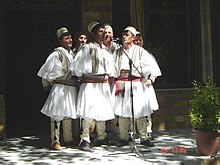Iso-polyphony

Iso-polyphony is a name for a folk style of singing that is native to the historical region of Epirus in southern Albania and northwestern Greece and is particularly cultivated in the southern Albanian regions of Toskëria and Labëria . It is a special type of polyphony ( polyphony with independently guided voices) in folk music .
The style is cultivated by all ethnic groups living in the region, including Albanians , Greeks , Slavic Macedonians, and Aromanians .
description
In iso-polyphonic singing, there are usually two or three voices that are sung by soloists and are also accompanied by a deep drone , from which the prefix iso comes. The voices are largely independent of one another, but are closely interrelated. The drone is usually sung by a choir . A precisely tuned pitch is not adhered to, but sung in a narrow area around a tonal center, which creates the impression that the choir is singing at this pitch. Overall, the harmony of the voices results in a monotonous sound impression.
The vocal ensembles usually consist of male singers, but occasionally female singers also take part. Sometimes the chants are also accompanied by instruments. There are also purely instrumental iso-polyphonic ensembles.
In southern Albania, different genres of Albanian folk songs are sung isopolyphonically. The Bejte is a humorous piece of simple verses that occurs all over Albania, but is only sung isopolyphonically in southern Albania. The Borrohite , on the other hand, is a funeral song sung by the shepherds of Labërias.
history
Probably the oldest known iso-polyphonic song is the E qara me bote, me grikë from the region around Gjirokastra , which goes back to an ancient ritual of the dead and is described as a fragment from a “folkloric tragedy ”. It probably goes back to a collective lamentation .
The style has evolved over the centuries, with several composers and performers being known by name since the 19th century.
Regional particularities
The main difference between the style sung in Toskeria and Labëria is the execution of the drone. While in Toskeria the drone is sung continuously with the help of graduated breathing on the vowel e , in the Labëria the drone is also sung to the rhythm of the lyrics.
There are several regional sub-styles, which are designated by the name of the respective region or locality, for example Devolliçe from the Devoll region or Dropullitçe from Dropull . Some of them have peculiarities such as the two-part dy vetçe Dukatçe from the village of Dukat , in which the voices are particularly close to one another and which mostly deal with death .
Music business
In most places in southern Albania there is at least one singing ensemble in which the singing style is cultivated. The ensembles perform at social events such as weddings , Thanksgiving holidays, and funerals .
Albanian polyphonic music is promoted through various activities by the Albanian Music Council. Furthermore, since the award by UNESCO, a program to protect this tradition has been carried out with the support of the Japanese government.
A national festival for iso-polyphonic music has been held in Vlora since 2001 . The music is also performed at other Albanian folklore festivals - for example at the Gjirokastra National Folklore Festival .
Reception and musicological research
The style of singing was inscribed on the UNESCO List of Masterpieces of the Oral and Intangible Heritage of Humanity in 2005, and was added to the Representative List of the Intangible Cultural Heritage of Humanity in 2008 .
The Albanian composer and ethnomusicologist Vasil S. Tole , who mainly deals scientifically with the folklore music of his homeland, has published books and articles on this form of music since 1999. Starting in 2006, with the help of the US Embassy, he created an encyclopedia on Albanian polyphony.
literature
- Vasil S. Tole: Folklori Muzikor - Polifonia sqiptare. , SH.BLU, 1999
- Vasil S. Tole: Inventory of performers on iso-polyphony . Ed .: Albanian Music Council / UNESCO. Tirana 2010, p. 52 f . ( Copy on isopolifonia.com (PDF; 691 kB)).
Web links
- Proof of relevance from UNESCO for recognition as a cultural asset (English)
- Isopolifonia.com - Singing Style Website (Albanian / English)
Individual evidence
- ↑ Jane C. Sugarman: Engendering Song: Singing and Subjectivity at Prespa , 1997, ISBN 0-226-77972-6 , p. 356
- ↑ a b c d Artist database for iso-polyphonic music (PDF; 691 kB), isopolifonia.com
- ↑ Faik Konica : Shqipëria, kopshti shkëmbor i Evropës Juglindore , Volume 2, Chapter IV , p. 207, Pristina 1997
- ↑ a b c d http://www.unesco.org/culture/ich/index.php?lg=en&pg=00011&RL=00155